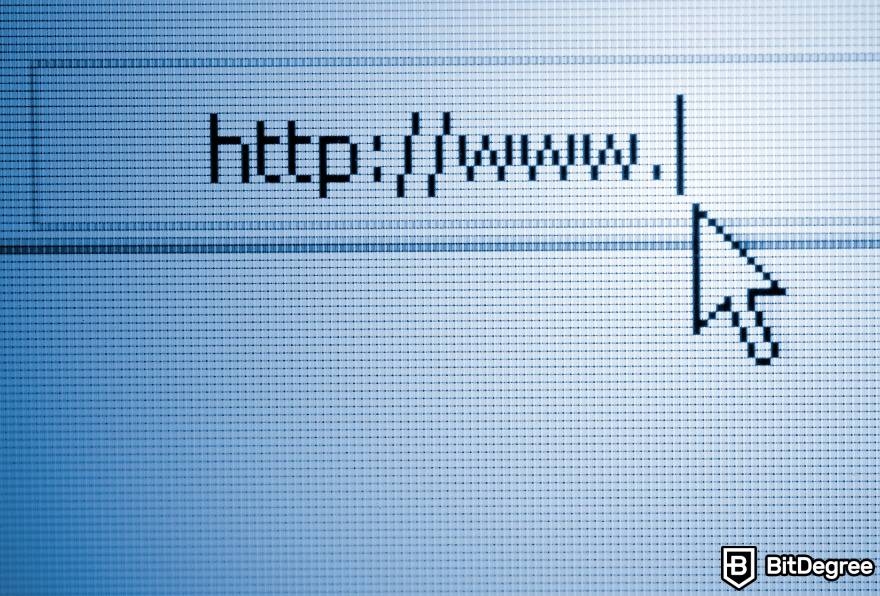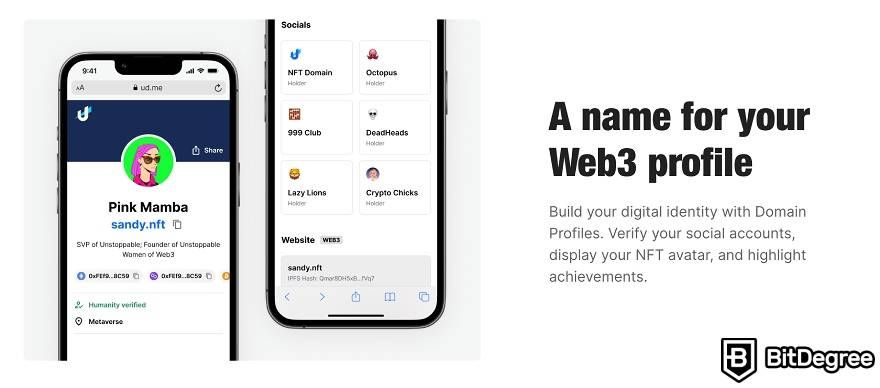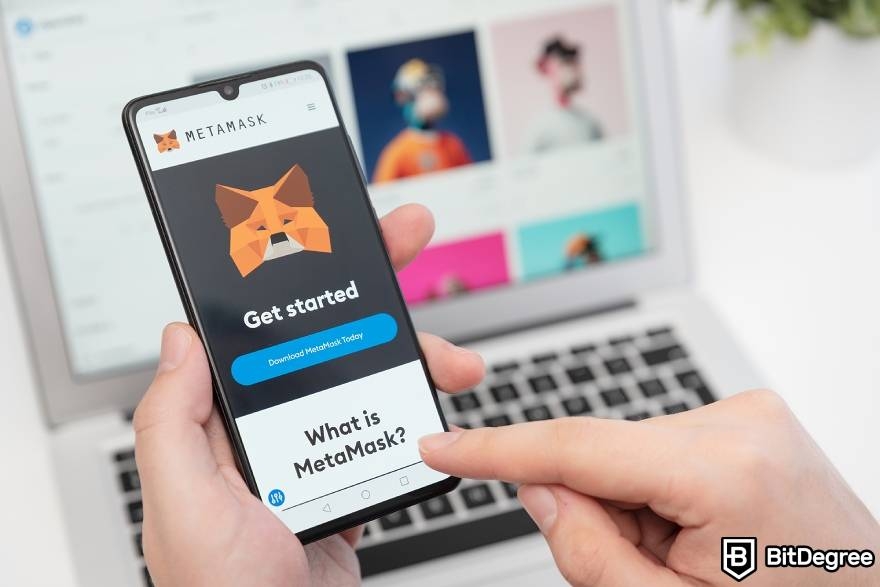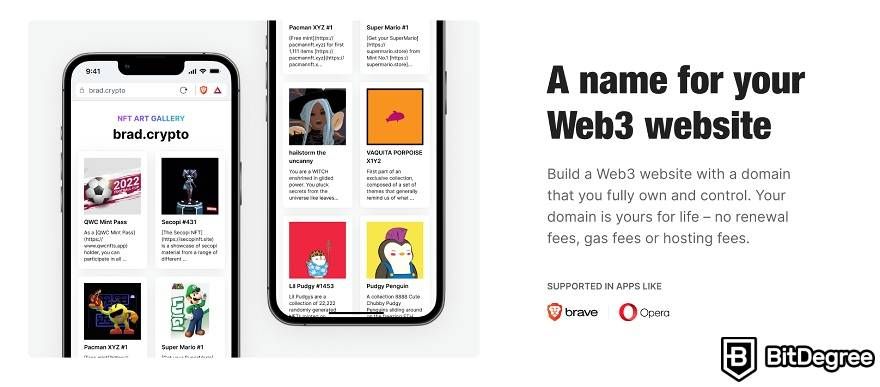Stop overpaying - start transferring money with Ogvio. Sign up, invite friends & grab Rewards now! 🎁
NFT domains are a relatively new and intriguing concept that has seeped through the entirety of the Web 3.0 space. So much so, actually, that many people would consider an NFT domain to be one’s mandatory first step when exploring Web3, in general! This is why it’s important to get NFT domains explained, and to understand both how they work, as well as the significance that they carry.
We’ll cover what is an NFT domain, and how these specific domains are different from their traditional counterparts. There’s a pretty good chance, however, that you might be looking for “.NFT” domains - specifically, crypto domains that end with “.NFT”. If that’s the case, do note that I’ll cover how to buy NFT domains, as well.
Whatever the case might be, keep in mind that, in order to purchase some NFT domains for yourself, oftentimes, you will need to have crypto (Ether) in a dedicated wallet already. If you still haven’t taken care of this, I’d highly recommend checking out one of the top-rated crypto exchanges on the market - these platforms will make your ETH acquisition process quick and worry-free!

Did you know?
Subscribe - We publish new crypto explainer videos every week!
DEX vs CEX: Which is Best for YOU? (Explained with Animation)


Table of Contents
- 1. Before We Start: Setting the Scene
- 2. NFT Domains Explained
- 2.1. NFT Domains, as Crypto Wallet Addresses
- 2.2. NFT Domains, as Actual Domain Names
- 2.3. NFT Domains, as Social Profiles
- 3. Types of NFT Domains
- 4. How Does an NFT Domain Work?
- 5. The Negative Sides of NFT Domains
- 6. Buying .NFT Domains Names
- 7. Conclusions
Before We Start: Setting the Scene
In order to get NFT domains explained properly, and for you to understand the key aspects revolving around this topic, we need to first take a step back, and look at how traditional domains work.
Latest Deal Active Right Now:A traditional domain is something that you interact with every single day, if you use the internet at all. Whether it be facebook.com, wikipedia.org, or google.com, all of these websites are equipped with a traditional domain name.
Underneath that domain name, however, there’s a string of numbers that leads to a specific location on a database. This location is where the website that you’re visiting is housed at. Meaning, instead of the domain name (URL), you could just enter the specific string of numbers into your browser, and you would still be directed to the relevant website, assuming that you’ve entered the right combination.

So, in short, the first part of this “NFT Domains Explained” tutorial is understanding that a traditional domain name is just something that makes accessing a certain website simpler - it’s definitely not the ONLY way to access the site, though. This is important to keep in mind due to the fact that NFT domain names work somewhat similarly.
One more point that I’d like to mention before we get into the actual “what is an NFT domain?” question is that traditional domains are indexed by major search engines, as well as the fact that official domain endings are managed by services such as ICANN. This will become very important when talking about the cons of .NFT domains, later on in the guide.
With all of that being said, let’s move on to discussing the aspect that you’re probably most interested in - what is an NFT domain?
NFT Domains Explained
NFT domain names are a special type of non-fungible token that’s stored in your cryptocurrency wallet, and that doubles as two things - the aforementioned domain name itself, as well as a unique substitute for your wallet address.
This second point is actually very notable - so much so, that it should even be considered as the primary use case for NFT domain names! Allow me to explain.
NFT Domains, as Crypto Wallet Addresses
If you own a cryptocurrency wallet, you’re probably well-aware of the fact that your wallet address is, well… Let’s just say, less-than-readable, for most human beings. It’s comprised of randomly generated letters and numbers, and is very long and convoluted.
As you get NFT domains explained, you’ll quickly learn that these domains were introduced as a direct response to this problem - a way to name your wallet, and make transacting with crypto much simpler, in many cases.
So, yes - whether you own .NFT domains, or are looking into what is an NFT domain, in general, the (arguably) primary feature of these domains is to function as wallet address substitutions.

Before we move on, there’s one more point that you should know, in regards to what I’ve said above. If you purchase an NFT domain, and want to use it as your wallet address, it will *NOT* work with any and all crypto services out there.
Instead, the company (registrar) that you’ve bought the domain name from needs to have a partnership with the specific service provider - only then will you be able to use your new wallet addresses.
That makes sense, however - since, at its core, you’re purchasing an NFT, it needs to be compatible with any other service that you might want to use it with. This compatibility is actually one of the bigger selling points for many NFT domain name registrars out there - the more services they have partnerships with, the more freedom you will have to use your NFT wallet address.
NFT Domains, as Actual Domain Names
With wallet address substitution functionality cleared up and out of the way, we can move on with this “NFT Domains Explained” tutorial, and talk about the “domain” part of the deal.
Now, in order to grasp what’s so special with NFT domain names, it’s very important that you understand how NFTs work, in general.
The unique thing about non-fungible tokens is that they are exactly that - non-fungible. It simply means that each token is unique, and doesn’t have an equivalent. This is ensured with the help of blockchain technology - since each token is minted on the respective blockchain, the non-fungibility is quite easily provable.

To sum up everything I’ve said above, NFT domains are a special type of blockchain-based token that can serve both as a unique wallet address, as well as an actual domain name that leads to a website.
Whenever your purchase an NFT domain for yourself, what you buy is actually a token - it’s almost completely the same as if you were to purchase any other NFT on a designated marketplace, such as OpenSea. The NFT is minted, and the token is transferred to your wallet - you may then choose what you want to do with it.
Depending on the .NFT domain name provider that you’ve chosen, you may either have full custody of the domain name, or it might come equipped with a subscription service, same as with any other traditional domain. This is, obviously, not ideal - most people would opt to purchase and have full custody of their NFT domains. This is why it’s important to pick the right provider, as well! More on that later in the “NFT Domains Explained” tutorial, though.

- Secure and reliable
- Accepts fiat currencies
- Lots of trading options
- Reputable exchange
- Accepts fiat currencies
- Offers various trading options

- Huge trading variety
- Regulation-compliant around the globe
- Fair trading fees
- Beginner-friendly
- A wide array of features
- Vast number of different crypto coins & tokens

- Beginner-friendly
- Secure
- Decent trading and withdrawal fees
- Crypto.com Visa Card
- Automated tools & bots
- Ecosystem synergy with CRO
NFT Domains, as Social Profiles
Earlier in the article, I mentioned that NFT domains have two major use cases - traditional crypto wallet address substitution, and actual domain name functionality.
That is true - however, as the world of Web 3.0 advances, another less-objective use case is becoming more and more prevalent and important. That would be NFT domain names acting as social profiles.
Specifically, the NFT domain can act as a handle for your presence online. Some platforms allow you to link all of your social media (Twitter, Meta, Instagram, TikTok, etc.) under a single, verifiable page. There, you could also showcase your NFT collection, your achievements on the blockchain, and so on - there’s a lot of customization involved!

Whether it be to “flex” your expensive NFT domain name, or to build a recognizable presence online, NFT domain handles are slowly becoming more and more popular. All it takes to observe this is to look at some of the Twitter handles of famous celebrities and notable individuals - quite a few of them are going to have NFT domain names, set as their handles or usernames.
At the very least, this just goes to show that, while there are clearly established purposes that NFT domains serve, new ones can emerge, at any point in time, making this concept even more universal than it already is.
Types of NFT Domains
Moving on, as you learn more about what is an NFT domain, or how to buy NFT domains on different registrars, you will eventually come across the topic of domain name endings. This is a crucial factor to get familiar with, and understand.
Same as any other, traditional domain out there, NFT domains have endings. An example of that would be the “.NFT” ending, which I keep on referencing throughout this “NFT Domains Explained” tutorial; however, popular endings also include:
- .blockchain
- .crypto
- .xyz
- .dao
- .888
- .eth
- .zil
- .x
- etc.
The ending of your choice is going to depend largely on what it is that you prefer. Truth be told, it’s almost completely a preference-driven thing - shorter domain name endings, however, are usually a bit more lucrative, since they look “cleaner”. This is rather subjective, however.
Now, the one major thing to keep in mind here is that many crypto endings are kind of exclusive to the registrar that offers them. In order to understand this better, allow me to give you a pretty well-known example.
Unstoppable Domains is one of the leaders in the NFT domain name registrar industry. At some point in time, among its myriad of domain name endings, UD started offering the ending “.coin” - pretty cool!

Or, it would be, if this ending wasn’t already being offered by another company (Emercoin), for some time. However, Unstoppable Domains did not know this, when they first started selling the “.coin” domain ending.
As soon as UD became aware of the mistake, they immediately pulled their “.coin” offering from the available domain ending list, and issued refunds to their customers who had already bought domain names with these endings. The refund amounts were three times what the customer paid, initially.
So, as you can see, it’s a pretty big deal! While there’s no rule that would be “set in stone”, in regards to offering the same domain names, it’s a concept that’s quite shunned upon, within the industry. On top of that, it creates a huge amount of confusion for the user, and at the end of the day, it really isn’t a viable option, either way.
How Does an NFT Domain Work?
With all of the major aspects of NFT domains discussed and contemplated, all that’s left to do now is to put everything into perspective, and get to know the process behind what happens when you acquire one such domain for yourself.
The very first thing that you will need to do is create or purchase a crypto wallet (if you don’t already have one), and fund it with some ETH. You need to make sure that the wallet is non-custodial - in other words, exchange-based wallets won’t do.
Now, you need to establish the domain name ending that you want to purchase. I mean, as I told you earlier in the “NFT Domains Explained” tutorial, different endings will be offered by different registrars. Once you know which domain endings you prefer, it will make the process of finding NFT domains for sale much easier.

After you pick out your preferred domain ending, visit the registrar, and make the purchase, this is when your domain name will be minted, as an actual NFT. The minting happens on the blockchain, and the token is then transferred to your wallet.
Within your wallet, you may view the NFT domain as just that - an NFT, as if it were any other non-fungible token that you might possess.
From that point onwards, the processes are going to be quite different, depending on the platform that you’ve chosen to purchase your NFT on. Oftentimes, you’ll be able to create a website, right then and there.
These websites, though, are usually going to be completely static. This is because of hosting issues - NFT domain-possessing websites won’t have a hosting service attached to them, and thus, there won’t really be a way to make full-fledged sites.

Instead, your website would be based on some sort of a designated database, usually - IPFS. Even though the website would be static, though, you would still be able to customize it, quite a bit.
Then, of course, you could also have a social profile section. It would be based on the registrar (if it’s even an option, to begin with), and the customization aspect of it would depend on the underlying platform, as well.
Lastly, wallet address substitution and integrations. If you’ve read the entire “NFT Domains Explained” article up to this point, you probably already know that, once you purchase a domain name, and transfer it to your wallet, that wallet address of yours is now eligible to be substituted with the domain name, with the select services that the underlying registrar supports.

Some domain name vendors, however, allow you to attach multiple wallet addresses to your domain name. So, if you have a few different wallets (say, for different networks), you might be able to associate all of them with your NFT domain. Thus, whenever someone sends you funds, no matter which wallet they’d send it to, they could still be able to input your handle, instead of the traditional wallet address.
Do keep in mind that, if you bought the NFT domain for a one-time fee, and it’s not a subscription service, the NFT now belongs to you, and you alone. Meaning, you can choose to hold it, use it, tranfer it to someone else, or even sell it, completely. In that regard, it acts as a traditional NFT - you have full control and ownership of the token, as well as any of the perks and benefits associated with it.
The Negative Sides of NFT Domains
Up to this point in the tutorial, we’ve covered all of the major aspects of what is an NFT domain, and how these domains work. On top of that, we’ve also talked about .NFT domains for sale, too - how you can purchase them, and what the entire process would look like.
Now, it’s worth acknowledging that there are some less-than-positive aspects associated with this concept, too. Specifically, in order to have a thorough “NFT Domains Explained” article, we do need to also look into the negative sides of these domains, and evaluate whether or not they “break the deal” for you.
Straight off the bat, I can tell you right now - the biggest “con” associated with NFT domains is the fact that most modern search engines do not recognize them as domain names.

This goes back to what I told you about at the beginning of the article, when I mentioned ICANN and other domain management companies. How do you think search engines differentiate between a domain name, and a simple search query?
Well, the answer is pretty simple - if your domain name ends with one of the agreed-upon endings (i.e. .com, .net, .org, and so on), then the search engine understands that this is pointing to a website. NFT domain endings aren’t “universally agreed upon”, at least not yet - thus, if you were to google “vitalik.eth”, this wouldn’t lead you to any website.
Or, to put it even more simply - NFT domain names are not indexed by Google and other major search engines.

Of course, there are still ways of how you can access a website with an NFT domain. Most of the time, all that you’d need to do is install a dedicated browser extension. This, however, is quite user-unfriendly. By extent, it’s not really viable for mass adoption, and isn’t a strong argument for people who are looking to buy NFT domains.
On the topic of mass adoption, this is where another glaring “negative” can be observed - the fact that NFT domains are still a very new concept (comparatively speaking), and thus, there are no guarantees that they will “stick”, for a long period of time.
In and of itself, this is a philosophical question that’s quite impossible to answer, as of me writing this “NFT Domains Explained” guide. The thing that should really be considered, however, is this - which NFT domain registrars are going to be around, whenever mass adoption actually happens.
Depending on the answer to that question, you might be one of the lucky few who bought a lucrative domain name super-early, or you might lose out on a lot of money, with your domain eventually becoming redundant.

Why would that happen? Well, as you might recall, it all boils down to the fact that your NFT domains aren’t going to be functional in themselves - instead, it’s all up to the registrar to create as many opportunities for you to use the domains as possible.
Some of those opportunities come in the form of social hubs and multiple wallet address additions. Others, however, have to do with partnerships and integrations - if your registrar of choice goes down, and you’ve bought, say, .NFT domain names from it, chances are that they won’t be useful to you anymore.
It is thus very important to focus not only on the NFT domains that you want to acquire, but also on the company behind them. While the future is quite unpredictable, you should always approach the topic with prior research done, and educated guesses made.
Buying .NFT Domains Names
Before I let you go, there’s one last point that I need to mention - it has to do with .NFT domains for sale. At the beginning of this “NFT Domains Explained” guide, I mentioned that you might have come here searching for .NFT domain endings, specifically, and if that’s the case, I would tell you about them, as well.
Well, that time has come.
.NFT domain name endings are among the most popular endings, simply due to the fact that they convey a very clear message (you being an NFT fan, or simply - a fan of crypto), and are also very short, too.

If you’re planning to buy NFT domains, there’s really only a single place where you’d need to look - the aforementioned Unstoppable Domains.
This specific platform features .NFT domain name endings, among others. As I’ve said earlier, it’s one of the most established registrars of its kind, with constant updates being issued, and new partners / integrations added.
The buying process, in itself, demands an entirely different article - you can check out my dedicated tutorial on how to use Unstoppable Domains for that. To keep it short, however, it would look a little something like this:
- Connect your wallet to Unstoppable Domains;
- Choose a domain name with an .NFT extension;
- If the price fits your budget, make the purchase;
- Mint the NFT on the Polygon blockchain;
- (OPTIONAL) Bridge your NFT to Ethereum;
- Manage all of your NFT domain-related details straight from the Unstoppable Domains dashboard!
As you can tell, while the process of buying NFT domains isn’t necessarily very short, it’s not exactly complicated, either. Unstoppable Domains does a great job of guiding the client through the entire process - even if it’s your first time performing a transaction like this, there really is nothing to worry about!
Conclusions
A sentiment that echoed throughout the entirety of this “NFT Domains Explained” tutorial is that of NFT domains being a rather lucrative and exciting concept. Even though the Web 3.0 ecosystem is still very young, and there are major changes and updates happening seemingly every other week, NFT-based domains seem to have stuck around.
That makes sense! With their primary purpose being that of traditional wallet address substitution - something that is directly aimed at simplifying user interactions with crypto -, the concept has a clear use case, with new ones coming up every so often.
If you’re familiar with crypto, as a whole, understanding how NFT domains work shouldn’t be too difficult, at least when it comes to the basics. Sharing features with any other non-fungible tokens, you may choose to view such domain names as NFTs with added utility - it’s as simple as that!
As a reminder, if you’re looking to buy NFT domains for yourself (whether it be domain names, in general, or ones that end with .NFT), you need to visit a designated registrar platform. In this case, Unstoppable Domains would probably be the best pick - the platform offers a one-time payment model (no subscription fees), a large number of additional features, and some top-level user-friendliness.
With all of that being said, thanks so much for reading, and until next time!
The content published on this website is not aimed to give any kind of financial, investment, trading, or any other form of advice. BitDegree.org does not endorse or suggest you to buy, sell or hold any kind of cryptocurrency. Before making financial investment decisions, do consult your financial advisor.









